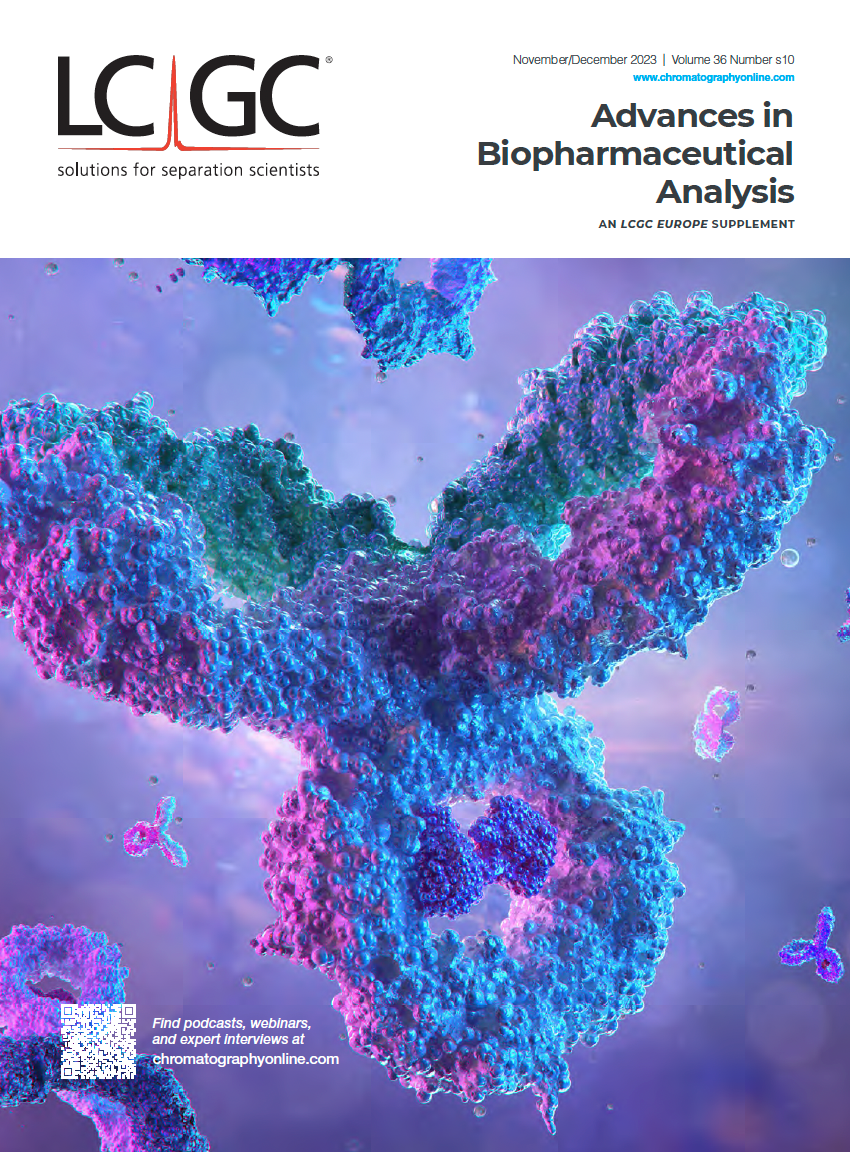Critical Thinking On Characterization
Guest editors Valentina D’Atri from the University of Geneva in Switzerland and Jelle De Vos from the Research Institute for Chromatography (RIC) in Belgium, interviewed leading luminary of biopharmaceutical analysis, Reed Harris on critical quality attributes (CQAs), contemporary trends in biopharmaceutical characterization, and how he earned the moniker “Dr. Doom.”
Jelle De Vos: Chromatographic methods can detect structural variants with altered function to allow the identification of critical quality attributes (CQAs). Ion exchange chromatography (IEC), hydrophobic interaction chromatography (HIC), and size exclusion chromatography (SEC) are the key separation techniques. However, the link between the monoclonal antibody (mAb) structural changes and the effect on drug bioactivity is not always evident. How complicated is the process to determine what this link is?
It should not be too complicated. Chromatographic methods provide opportunities to collect intact material found in peaks or regions for molecular characterization and biological assay testing, such as potency testing and Neonatal Fc-receptor (FcRn) binding, which is relevant for pharmacokinetics. There is one caveat: The fractions collected from IEC and HIC methods should also be reanalyzed by SEC to determine if aggregated forms are enriched because aggregated forms may have an outsized effect on biological activity, thereby confounding the result interpretation.
For IEC fractions, it is also useful to consider what the molecular charge differences will be at physiological pH 7.4; for example, a histidine residue that mediates chromatographic resolution when acidic mobile phases are used could be protonated during chromatography but unprotonated at physiological pH, so the physiological effects may be negligible.
Valentina D’Atri: The analysis of mAb charge variants by IEC can sometimes be challenged by the presence of a highly ordrered structure (HOS) acting as acidic forms. What could help to solve the puzzle?
Re-analysis of collected IEC fractions by isoelectric focusing, such as imaged capillary isoelectric focusing (icIEF), can help identify true charge differences. For example, deamidated, sialylated and proline amide forms will continue to be resolved by IEF. Conversely, HOS variation that gives an IEC separation due solely to charge presentation differences that affect interactions with the IEC column may not be resolved using icIEF. For example, an aspartate to isoaspartate change can affect charge presentation because the isoaspartyl modification rotates the polypeptide chain and extends the polypeptide chain due to incorporation of a methylene group, but the true charge difference between aspartate and isoaspartate side-chains is negligible, so modification impacts need to be evaluated based on the structural difference, not the charge difference.
De Vos: Peptide mapping used as a multi-attribute method (MAM) approach is gaining attention because it allows us to follow different CQAs What are the regulatory challenges linked to this approach?
Health authorities worry about undetected variation that adversely affects product quality in ways that compromise patients. MAM is an excellent tool for monitoring multiple covalent modifications and variants, so it can address concerns about unexpected (non-model) variation when new peak detection is included in the analysis. Most of the MAM technical issues have been addressed, including sample preparation, chromatographic, ionization, and the use of reported (indicator) sites, as reviewed in Feng Yang’s 2023 mAbs article (1). MAM also has some liabilities that need to be acknowledged. Thiol modification information will be lost if the peptide mapping step is performed after reduction and modification. Deamidation at an ADCC-relevant site in the heavy chain may not be detected because this is found in a small Val-Ser-Asn-Lys peptide peptide that may not be resolved from the void (salt) flowthrough, requiring alternative RP-HPLC columns or additional enzyme digests. Modification distribution information is also lost by the peptide mapping steps; for example, heavy chain Asn297 afucosylation symmetry is important because only one heavy chain needs to be afucosylated to affect in vitro antibody-dependent cell-mediated cytotoxicity, so glycopeptide analysis using MAM may need to be complemented with methods that report distribution.
An analytical package should include targeted attribute quantitation where degradation-susceptible sites are studied in stability studies and during process monitoring along with some intact or fragment chromatographic methods to cover gaps and detect higher-order structural variants.
D’Atri: Can you describe how the development and characterization of mAbs transformed the life of analytical scientists in the latest years?
I entered this field with the false perception that the health authorities were adversaries. When I started interacting with reviewers and assessors, I realized that they are outstanding scientists responsible for protecting human health; they should be skeptical (trust but verify), and we need to provide them with the information they need to make important decisions. Some of the best experiences in my career were when I worked with health authority scientists and leaders, explaining our knowledge and approaches, and then incorporating their feedback into our strategies and submissions. We need to acknowledge the roles that many organizations such as CASSS, the Parenteral Drug Association, and the Asia-Pacific Economic Cooperation forum have played in improving sponsor and health authority interactions.
De Vos: Talking about career opportunities and risks for analytical scientists, what event led you to earning the “Doctor Doom” honorific?
I kept finding unexpected and variable-level modifications in our first therapeutic antibody, which began to annoy teammates because these discoveries were exciting for the analytical scientists but created new work for others. For example, the identification of sequence variants caused by mutations introduced during transfection meant that we needed a different cell line. Identification of an asparagine residue that deamidated during cell culture production required better process control. I learned to describe new findings in a more sympathetic way. Despite this, I earned the unfortunate “Dr. Doom” honorific from a project team colleague, as I was the person who always brought the unwelcome news. I remain convinced that the ability to identify unexpected variation is important for the regulatory credibility of any analytical program.
De Vos: What do you regard as the most game-changing technological development (in relation to sample preparation/chromatography/mass spectrometry) during your career?
For technical development, peptide LC–MS (including data processing) provided huge gains in speed and sensitivity for protein characterization, especially for modification identification. I used to run a laboratory that did amino acid analysis and Edman protein sequence analysis, both of which have been made obsolete by peptide LC–MS capabilities. One caveat: It is important to maintain some discipline regarding what can be claimed with only mass information. I sometimes see people draw out carbohydrate structures with all the linkages named when they only have the mass; the author can claim that the result is consistent with a proposed structure, but that’s all they can claim unless they’re also running tandem mass spectrometry (MS/MS) or other methods to get structural information.
D’Atri: Do you believe that you witnessed the biggest changes within the biotechnology field throughout your career, or is the best yet to come?
That’s a broad question. For therapeutic proteins, the basic process and analytical technologies are very mature now, which enables productivity optimization, but we have to continue to encourage curiosity and innovation. There are still unknowns and things that we should understand better. Leaders and scientists need to ask big questions — What causes immunogenicity? Why does this take so long? Is there a better way to get product quality information? How can we reduce process and testing variation? — and then give people time to work on those questions.
De Vos: What are your thoughts on the new modalities, such as gene therapy products, viral vectors, oligonucleotide drugs? Will these reshape the landscape of analytics just like when monoclonal antibodies made their mainstream introduction around 20 years ago?
The analytical strategy framework that we have used for therapeutic proteins will remain necessary for new modalities. This means deciding three things: What to measure, how to measure, and acceptable results.
Biotechnology has also made it respectable for top-notch scientists and engineers to work in industry, so I expect that all this talent will drive rapid advances for new modalities.
References
(1) Yang, F.; Zhang, J.; Buettner, A.; Vosika, E.; Sadek, M.; Hao, Z.; Reusch, D.; Koenig, M.; Chan, W.; Bathke, A.; Pallat, H.; Lundin, V.; Kepert, J. F.; Bulau, P.; Deperalta, G.; Yu, C.; Beardsley, R.; Camilli, T.; Harris, R.; Stults, J. Mass Spectrometry-Based Multi-Attribute Method in Protein Therapeutics Product Quality Monitoring and Quality Control. mAbs 2023, 15 (1). DOI: 10.1080/19420862.2023.2197668
About the Interviewee
Reed Harris retired in 2022 after a 39-year career in biotechnology, starting as a research assistant and finishing as a senior staff scientist in the Roche-Genentech Pharma Technical Development department, with strategic, review, and teaching responsibilities. His former roles includ: Head of Investigational Medicinal Product Quality for Roche, senior director of Analytical Development & QC, analytical characterization scientist for Herceptin and Xolair, and head of a protein structure lab. He was the global (Genentech + Novartis) Xolair technical development team leader from Phase 2 through licensing. Reed is a CASSS Distinguished Fellow and has been an author of 49 publications, including 14 as corresponding author. He was a leader in the development of Roche-Genentech’s strategies for post-approval comparability exercises, clinical and commercial specifications, the identification of critical quality attributes, linking structure to function, the use of a risk-based Quality by Design approach for control strategy development, unexpected protein modification identification, and curiosity-based thinking.

About the Authors
Valentina D’Atri holds a PhD degree in Industrial and Molecular Biotechnologies, and she is currently a Research and Teaching Fellow at the University of Geneva, Switzerland. Her interests and research activities focus on the development of cutting-edge LC–MS analytical workflows for the detailed characterization of innovative therapeutic drugs such as biopharmaceutical proteins, therapeu-tic oligonucleotides, and viral vectors. She has currently authored over 55 peer-reviewed contribu-tions including articles and book chapters.
Jelle De Vos currently works at the RIC group as an expert on the development of chromatography methodologies for the analysis of complex biopharmaceutical samples. He focuses on pushing the boundaries of separation science and has published over 30 articles on advancing the performance limits of ultrahigh-pressure liquid chromatography technology and the development of microfluidic technology for liquid chromatography.

Characterizing Polyamides Using Reversed-Phase Liquid Chromatography
May 5th 2025Polyamides can be difficult to characterize, despite their use in various aspects of everyday life. Vrije Universiteit Amsterdam researchers hoped to address this using a reversed-phase liquid chromatography (RPLC)-based approach.
New Method Explored for the Detection of CECs in Crops Irrigated with Contaminated Water
April 30th 2025This new study presents a validated QuEChERS–LC-MS/MS method for detecting eight persistent, mobile, and toxic substances in escarole, tomatoes, and tomato leaves irrigated with contaminated water.

.png&w=3840&q=75)

.png&w=3840&q=75)



.png&w=3840&q=75)



.png&w=3840&q=75)







